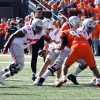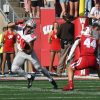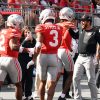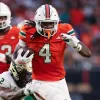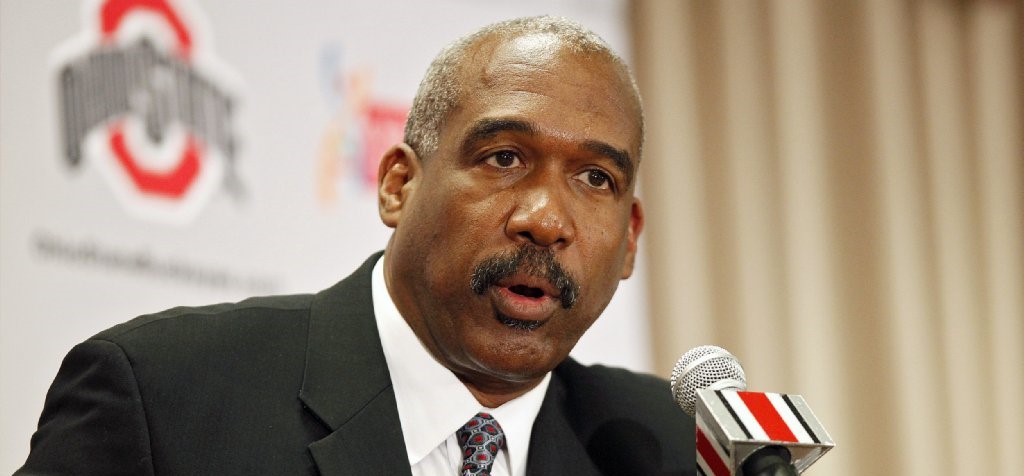
Amid the COVID-19 crisis, Ohio State athletic director Gene Smith took time out of his busy schedule, which includes daily calls with Big Ten ADs, to answer questions from members of the media.
What follows is a bullet-point rundown of everything Smith had to say on the morning of April 10:
- The athletic directors in the Big Ten have been having morning calls for three weeks now. Every morning we talk and most of our time has been spent on what we were dealing with in the moment. Just from a compliance point of view on what type of activities our coaches could operate under. We’re dealing with the spring student-athlete issue, the winter student-athlete issue for a myriad of different things that we have been dealing with. We have not begun on discussions or models for the football season.
- It’s interesting that we jump to the season and we forget about the health and safety of our players. Just to put it in perspective, remember that our players would be typically in spring ball. In fact, we’d be playing our spring game tomorrow. So that means they would have had all of that conditioning. And then normally, they’d come back in the summertime taking classes working, doing internships and working out. And we won’t have that.
- And so one of the things that we’ve talked about that is of the utmost importance is what are the things that we have to put in place relative to return-to-play for the player. Is that an eight-week, six-week, four-week schedule for them to re-acclimate into a grueling, physical, competitive environment to make sure we avoid muscle-tissue issues, sprains and strains, tendons and ligaments and all the contusions, all those types of things that could occur, but because you haven’t been working out at the same level of intensity that we have historically prepared them? So they just can’t come back and play – those days are gone.
- So we really haven’t begun to talk about models. I know everybody’s doing that. But we’ve been focused on that. How do we do that? Now, that determination, that schedule, that timeline, will allow us to move in a different way in looking at models for the season. The other thing is this is a collective decision around the country. There has to be a national issue resolved for this. So we have athletic directors, conference commissioners, American Football Coaches Association, the NCAA committee on competitive safeguards, medical aspects of sports, the Football Oversight Committee. There’s an NCAA COVID-19 advisory panel, we have one in the Big Ten. So all these entities have to collaborate to get to a point where we can even think about what would be the right model for the season after return or what the return-to-play model is.
- So obviously, there’s a lot there that I just shared. But that is the big picture. We haven’t even begun to talk about all the scenarios that have been talked about publicly because we’ve been focused on the things that we had to focus on, to get to operate under this virtual space that we’re in, but also talk about return to play. I would also share something that you guys need to consider is many of these decisions will be based upon where the states are. If you look across the country now, there are different dates for when gatherings can return. And so, we obviously, in Ohio, we’re blessed to have our governor make some early tough decisions. And we’re able to maybe at some time return earlier than somebody else. So there’s a lot of layers to this decision-making process. And we’ll just have to wait and see.
- Relative to the budget, this fiscal year, we should end up in a good spot. Obviously, a lot of our revenue was in. And frankly, we did not unfortunately, we did not incur the expenses associated with the spring-sport operations with those games and the travel associated with it, frankly, some of the recruiting costs that would occur, and travel. Those expenses were obviously not there. So this fiscal year will be fine June 30. Next year, what we’ve done is just about done building our budget under normal circumstances, and we anticipate from the university, getting some directions we always – we work within the guidelines of the institution. We’ll get some guidelines on how to look at our budget relative to worst-case case scenarios. We’ll look at that and then we’ll do our own modeling based on our environment and what we know.
- We will be at about $10.2-10.3 million at the end of this fiscal year. We went through a reduction in our budgets and so we made significant cuts in our F-120 and F-121 budgets, understanding that we needed to do that any way, keep in mind, prior to COVID-19, we had made a decision not to increase football ticket prices, and during our tenure, every year we’ve done that. So we needed to try and fill that void any way, so we started down that process. So though we haven’t talked about our coaches of making cuts, we did talk to some of our coaches about the blessings that they have, and that we have, and we need to make sure that we help as many people as we can.
- Ryan Day did a great job actually, the first Big Ten coaches call was last Thursday morning, and he had already worked with our doctors, our strength and conditioning coach and to talked to the executive director of the American Football Coaches Association, and talked with some others. And so he put together some ideas that he verbalized with the other Big Ten coaches. and it is just a jumping point for considerations, no particular model, just the considerations that we needed to have. I really appreciate his leadership in that space.
- The football season is vital to the budget. It is the driver of our budget, our basketball contributes in a significant way. football is the elephant in the room. So, from that point of view, it is significant in funding all of our sports and everything we do for our student-athletes, but also is important to our community in a number of different ways. Obviously, economically, every contest has as a significant economic impact in Central Ohio.
- At least return 31 of our spring-sport student-athletes chose to return, while the other 39 decided to take the jobs that they had secured and we’re going to graduate school. Some of them tested the pro market. But 39 of them are coming back and that’s equivalent to 14.28 scholarships for us. So we decided that it was important to provide those kids that opportunity.
- Our coaches took cuts in their budgets in order to allow us to do that. And that is a little north of about $630k. Those scholarships are in and out of state, and they’re all equivalent. Now the student-athletes will cover a little south of $700k, so for the institution, frankly, it’s a revenue stream for those student-athletes to come back. And then, expenses associated with them having them on the teams, is a little north of $320k, discluding meals. Meals are probably around $40k, so the aggregate of that is in the $900k area, but we thought it was important to provide those opportunities.
- Hard date for football? I haven’t really talked to my colleagues about a hard date yet with that. For us, what we have to figure out, what is that return-to-play window? So let’s keep in mind for example, we know that at Ohio State, our summer session is virtual. So many of our student-athletes in football are not here. Some are, some are not.
- So normally we would start practice the first week in August, the last week of July, getting ready for Sept. 5. Do we feel we need longer now? I don’t know that. Do we feel we need a longer period of time to help them physically get Back into the grind. Maybe you need two weeks straight without pads? I don’t know that. That’s where we need the collaboration with the medical people, the strength coaches and everybody across the country has to occur. The hard date will come in relation to what we figure out there. And we have to figure that out yet.
- We have coaches calls every week. And I’ve encouraged our conference office and I know with some sports, this is happening. I know wrestling was April 7.
- We have to rely on the experts about when players can be around each other and safely practice or play. “Because we cannot put our kids at risk.”
- On the possibility of a shortened season: “I think it’s very difficult for us to think about models right now.” He says he hasn’t even thought about them yet but will if necessary. I enjoy having these types of hypothetical conversations with his colleagues.
- On if the season could happen on a different timeline: “I don’t know.” There are “a lot of elements in that” so he’s not going to go down that path yet.
- “We’ve been able to provide some nutrition to some kids based on their circumstances and where they are.”
- On the possibility of playing games without fans: “That one, I’ve thought about it a little bit. I struggle with that concept because when I first heard that, I thought, ‘OK, it could work.'” Then, he says, he realized they would’ve determined it is not safe for fans to be sitting together, so why would it be safe for the players? I haven’t heard enough from the experts or his colleagues to have a definitive opinion, and it’s important to hear from doctors.
- Having no fans at Ohio State football games would have a “major impact” on the athletic department’s finances and what they are able to do for their student-athletes.
- This will have a greater impact on Ohio State than the recession of 2008-09. This one “is a lot more devastating,” and it prevents face-to-face interaction with donors and makes the university not quite as aggressive in its approach with them.
- On how players can rehab injuries: “My concern when we started this was around that and around strength and conditioning overall.” The trainers and strength coaches, though, are “in lockstep.” He had concern, but he feels good about the response.
- The Big Ten and other Power Five schools are heavily reliant on the commissioners while also putting an emphasis on the Division I Football Oversight Committee.
- Can football games be played without students on campus? “That’s the other issue. I don’t know.” I wonder why it would be safe for student-athletes if other students are on campus. “At the end of the day, it doesn’t make sense.”
- hopeful there’s a football season in the fall “in some form or fashion.” I have to believe something’s going to happen.
- “We’re not going to rush this. We’ve got a major societal issue. Football’s important, I know that. But at the end of the day, we’ve got people dying.” I’m in favor of waiting and following the experts on the matter.
- Ohio State will soon begin the process of determining how much money the athletic department would lose by not having football games or not having fans at games. Each game brings in a net revenue of around $5-7 million.
- I haven’t had any conversations about pushing the football season back to the spring.
- Conversations about competitive balance were never brought up when considering whether or not to allow spring sport seniors to return for another season. “I think if it was football, we’d have a different conversation, to be quite frank.”
- Ohio State extended the football season-ticket deadline and will give reimbursements if there’s no season. Only 10 fans thus far have called and have been reimbursed.
For four free issues of the weekly print edition of Buckeye Sports Bulletin, no card required, sign up at the link here: https://www.buckeyesports.com/subscribe-4issue-trial/



